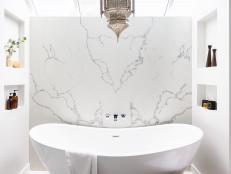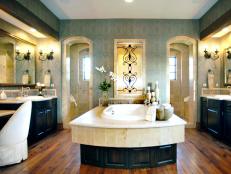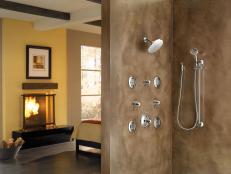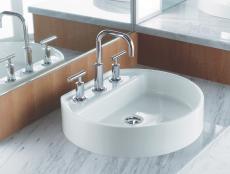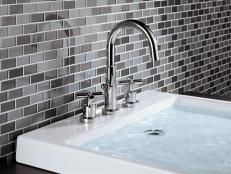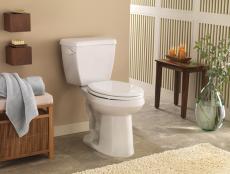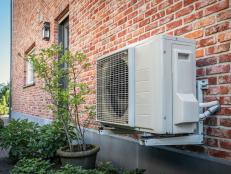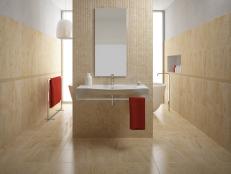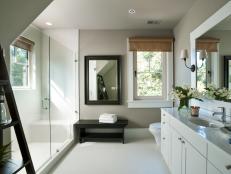Choosing a Bath Ventilation Fan

Those long, luxurious showers you enjoy so much could be hurting your house. How so? All that humidity and moisture in a concentrated space—your bathroom—creates the perfect breeding ground for mold and mildew, which can damage building materials, including drywall and wood framing.
Fortunately, you have a friend and defender—the bathroom exhaust ventilation fan. This little workhorse removes excess moisture, odors and even mold spores that can lead to health problems. In some areas, exhaust fans are required by building codes, especially if there's no operable window.
Small and unobtrusive, bathroom ventilation fans have benefitted from new technologies that make them smarter, quieter and more efficient than ever. Today's features include motion-activated lights or heat-exchanger ventilation. Depending on the options you choose, plan to spend $80 to $400 for a new ventilation fan. Add another $250 to $500 for professional installation by an HVAC contractor.
Before choosing a ventilation fan, make sure it's one that will be adequate for the size of your bathroom. You'll also want to prioritize your wants and needs with regard to noise level and features so that you'll get maximum satisfaction for your budget.
Proper Venting
Unfortunately, bathroom ventilation fans often are set up so that they exhaust air to the space between ceiling joists, especially if the bath is located on a lower level toward the middle of the house. Venting to the space between joists or into an unheated attic simply dumps excess moisture into the worst possible conditions—closed, dark spaces where humidity condenses on cold surfaces and mold can spread, damaging floors, walls and ceiling materials.
A smarter, healthier alternative is to connect your bathroom exhaust fan to vent ducts that channel the exhaust outside your home. Building codes typically specify this solution; regardless, it's the most sensible and safest method.
Keep in mind that properly vented ventilation fans also suck a lot of heated air out of your house. A remedy is to install a heat-exchange ventilator fan. These fans use warm, outgoing air to heat cooler, incoming replacement air. Heat exchanger models sell for about twice as much as standard bathroom ventilation fans.
Bathroom Ventilation Fans
See All PhotosAir Flow Capacity
Bathroom ventilation fans have different air flow capacities, measured in cubic feet per minute (cfm). To get the right fan for your bathroom, use the guidelines set by the Home Ventilating Institute: Your fan should have 1 cfm for every square foot of floor space in your bathroom.
For bathrooms larger than 100 square feet, figure your cfm requirements by adding:
- 50 cfm for every toilet
- 50 cfm for each shower, bath and combo
- 100 cfm for each whirlpool
Noise Level
Fan noise is rated by sones—a scale that represents degrees of loudness. A rating of 0.5 to 1.2 sones means the fan is exceptionally quiet. Ratings of 1.5 to 2.0 sones is very good. Fans rated in excess of 4.0 sones tend to be noisy.
Smart Options
Motion sensor activation turns on the fan when someone enters the bathroom. The fan speed can be pre-set to a low volume to remove the moisture of everyday tasks, such as shaving, and switch-activated for high-volume tasks, such as showering.
Overhead lighting can be switch-activated or turned on by a motion sensor.
Night light equipped models use a low-wattage light to help you find your way in the dark.
Humidity sensing ventilation fans automatically switch on when the unit detects high levels of humidity.
Built-in heaters, typically infrared heat lamps, add a little extra warmth when it's chilly outside.
Energy Efficiency
Bathroom ventilation fans that earn an EnergyStar label for efficient operation must be independently certified by the Home Ventilating Institute or the Air Movement and Control Association. The standards apply to any lighting options, too. EnergyStar ventilation fans use about 60 percent less energy than standard fans.
Many of today's bathroom ventilation fans feature quiet motors that let them perform at extremely low noise levels. These same motors are designed for energy efficiency. Panasonic's WhisperGreen line of ventilation fans, for example, employ a DC (direct current) motor that's quieter and more energy-efficient than EnergyStar criteria.
In some states, bathroom ventilation fans are required to meet building codes. In California, for example, Title 24 sets guidelines for the overall energy efficiency of new homes and additions. Bathroom ventilation fans are part of the HVAC systems that must be evaluated for energy efficiency under Title 24 before building permits can be issued.









